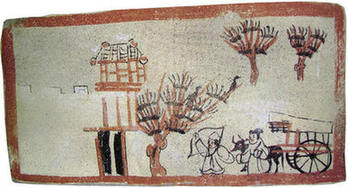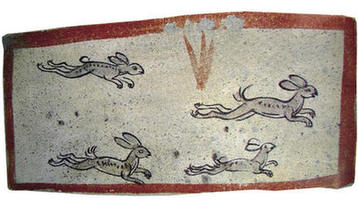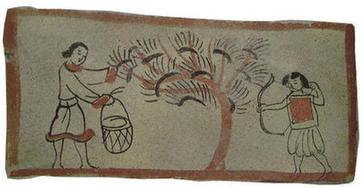|
Frescoed Bricks
 |
| A brick fresco depicting an outing. | As their name suggests, frescoed bricks represent a different approach to this art, with patterns painted directly on the brick's surface. White pigment was used to fill the background, and red to frame the edges, within which patterns of black, red, blue, yellow and some other colors were painted.
The Gobi desert 20 kilometers northeast of Jiayuguan City in Gansu Province is strewn with more than 1,400 large tombs from the Wei-Jin Period (220-419). Most of them have tomb chamber walls inlaid with frescoed bricks. Archeologists have excavated more than 10 of these tombs, unearthing over 700 frescoed bricks, among them the mounted estafette that has been printed on a souvenir stamp (See "The Colorful History of Chinese Stamps," November 2008). Mostly, one brick bears one composition, but there are a few instances where several bricks form a complete picture.
The Jiayuguan Pass, which the city is named after, lies in the central part of the Hexi Corridor, making it a strategic point on the Old Silk Road and the western end of the Ming Dynasty Great Wall. Chinese and Western cultures mixed in this area. During the Wei-Jin Period, frequent wars in the Central Plains area forced many residents to flee to the Hexi Corridor in Gansu. They brought with them production technologies and the culture of the Central Plains area, contributing further to the blending of different ethnic groups, economies and cultures in the Hexi Corridor.
 |
| Running hares in a Wei-Jin brick fresco. |
Unlike tomb murals in other areas that are devoted to the depiction of Heaven and Hell, the brick frescos found in the Jiayuguan tombs mostly reflect ordinary lives and the society of the time, providing important information on the politics, economy, military affairs, culture, ethnicity and folklore of the Wei-Jin Period. Their motifs include herding, farming, sericulture, hunting, brewing, cooking, livestock butchering, outings, entertainments, banquets, and other daily activities.
The majority of the frescos are related to general farming and animal husbandry processes, and are executed in great detail, indicating the importance of agriculture in the economy of the time. Farmers depicted include both the Han Chinese and ethnic minority groups such as the Xianbei, Qiang and Di. There are a large number of animal images including cattle, horses, sheep, chickens and camels. The Hexi Corridor had well developed animal husbandry, and during the Wei-Jin Period millions of livestock inhabited the area. Picking Mulberry Leaves and Protecting Mulberry Woods, which features a woman picking mulberry leaves while a man stretches his bow to prevent any creature from damaging his mulberry trees, reflects the division of labor between men and women at the time. Leading a Camel realistically depicts the traveling merchants on the Old Silk Road. And several frescos record how ancient Uygurs roasted kebabs on three-forked skewers. There are also depictions of musicians playing ancient musical instruments that today's researchers may not know about were it not for these images.
 |
| Picking Mulberry Leaves and Protecting Mulberry Woods. | According to expert opinion, these frescos done by folk artists realistically reflect the lives of farmers and herders in the Hexi Corridor during the Wei-Jin Period.
|
